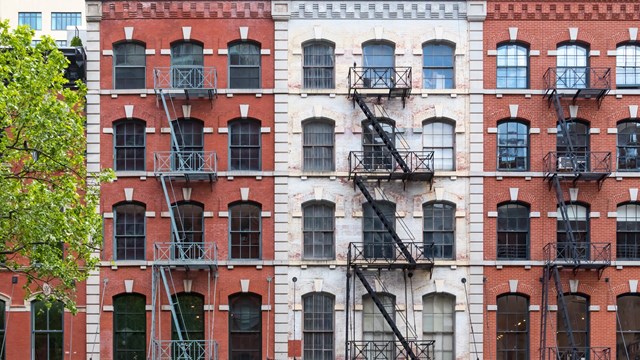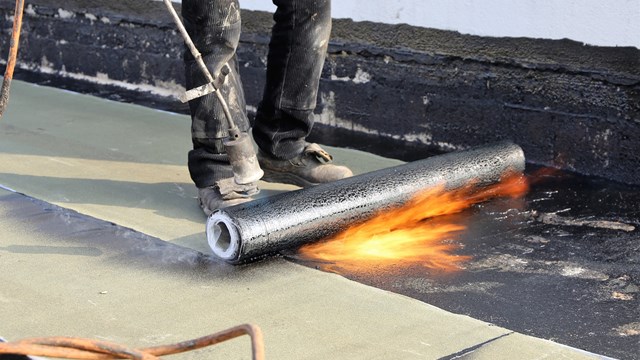They say that April showers bring May flowers. For the New York area's aging brick buildings, spring sprinkles and summer storms can bring much worse. From interior leaks to the liability nightmare of a crumbling and falling facade, the effects of water infiltration can devastate a building's structural integrity. Fortunately, with a knowledgeable team of professionals assembled, the process of waterproofing, otherwise known as exterior restoration, doesn't have to devastate the budget.
Exterior restoration, which can involve months of work and a hefty price tag, is usually not something a building embarks on until it is absolutely necessary, either because residents are finding water seepage or leaks inside their apartments or because the city mandates certain exterior maintenance work be done on a regular basis. Local Law 11/98 (the brand-new update of Local Law 10/80) mandates that any building over six stories be inspected every five years by the Buildings Department and a licensed architect or engineer, and any unsafe conditions be repaired.
One Upper West Side co-op that is currently in the throes of solving a water infiltration problem in their pre-war brick building has found the process daunting. "You have to educate yourself to be able to make intelligent decisions," says the board treasurer. "Learn the technical issues and, just like when treating a medical condition, always get a second opinion."
In the case of this 40-unit building, the symptom that something was amiss was damp plaster around the windows in certain apartments. Apparently water was getting stuck at the lintels and seeping inside instead of draining out through weep holes. After working with one engineer, which they subsequently fired, the board chose another engineer and also hired masonry consultant Michael Gurevich, president of New York City Brickwork Design Center, to help them analyze the problem.
"Don't accept at face value that repointing cures water infiltration," says this board member. "Push your professionals for explanations and try to understand the scope of the job before you sign a contract." He and his fellow board members have decided that their first engineer misdiagnosed the problem, and thus prescribed the wrong treatment. "What we really need is a more comprehensive drainage system, including flashing and weep holes, to make sure that water drains out of the building's exterior instead of seeping inside," says the board director. In most cases, the source of water problems is the roof and the parapet walls, where water tends to pool. Repointing the brick on the facade is a good way to rack up bills, but is not necessarily the solution to the problem.
"At least 50 percent of the money buildings are spending on exterior restoration is wasted," says Gurevich, "because real estate and design professionals are not knowledgeable enough about the process." In addition to serving as a consultant, Gurevich gives lectures and workshops to educate professionals about all aspects of brick masonry, from inspections to replacement techniques. The board treasurer mentioned above attended one of Gurevich's lectures and found it "highly informative."
Experts in the field say that assembling a team of competent professionals from the outset is the key to a successful exterior restoration project. Fred Rudd, president of Eichner Rudd Management in Manhattan, has brought many exterior restoration projects to completion. "If your managing agent is inexperienced [at overseeing waterproofing], consider changing firms or hiring an exterior consultant," he suggests. When looking for an architect or engineer, Rudd recommends that you find someone very knowledgeable not just about structures, but your particular era or type of building. For example, if your building is a landmark, find someone who specializes in exterior restoration for landmarks.
Lori Simon, director of marketing and sales at Kay Waterproofing, an exterior restoration firm in Manhattan, agrees. "Very often, people think our industry just gets a bunch of solutions from Home Depot and spreads it around," jokes Simon. The reality is that techniques for waterproofing range from addressing the outside of a building, through repointing or resurfacing, to replacing the inside structures, such as drains and flashing. With a wide range of options available, it is crucial to have someone on the team who can fairly evaluate their efficacy.
For a small job, it may be tempting to go directly to a contractor rather than a registered engineer. In the end, however, this may cost more than it saves. Paul Millman, PE, RA and partner at SuperStructures Engineers & Architects says, "I would never take the advice of a contractor alone. The best contractors are happy to work with an engineer."
One of the problems, Millman says, is that different contractors will suggest varying solutions based on their area of expertise. This makes it difficult to know which approach is best and will create a wide variance in the bids. "It's as if they are bidding on completely different projects," he observes. Experts suggest that it is important to have a full survey of the building done before embarking on work. Rudd comments, "In our experience, we have found that doing work piecemeal just moves the water around."
A licensed architect/engineer will use several tools to assess a building. First is a comprehensive exterior examination for obvious signs of distress such as cracks or deteriorating bricks and mortar. Next, a leak survey is distributed to tenants to determine where water is traveling to. In addition, special meters can be used to determine the moisture in the interior materials. All of this information contributes to the final program of repair which an architect, engineer or masonry consultant submits to a board. The proposal will include levels of priority for the work and estimated costs, so that buildings can form a budget and time frame for the project.
Gurevich tells just one of the many waterproofing horror stories he has turned into success. In a 15-story building that had been built after the Depression, shortcuts taken during construction caused multiple leaks. The board spent two million dollars to replace the brick veneer. But after two years, the building leaked worse than ever. This year, Gurevich was brought in along with the original architect and contractor and subjected the building to six months of rigorous testing. What they learned was that the building had improperly installed flashing on the upper floors. The end result was a new strategy for waterproofing at a cost of under $500,000. Today the building is leak free.
One of the benefits of seeing the full scope of work needed at the outset is that minor repairs can be linked with higher priority projects to save money. Michael Cantor, president of Cantor Real Estate in Brooklyn, manages predominantly brick buildings located in Brooklyn, Queens and lower Manhattan. He says, "If we're going to have a waterproofer come in, we want to do as much as we can to make the most cost-efficient use of the scaffolding and protective sidewalk shed that need to be erected."
When interviewing contractors, experts recommend a board look at several factors in addition to cost. For example, is this a reputable company that has been doing this work for a long time? Will they still be here five years from now if more work is needed? Can we live with them for the three months to a year that the project may take? Be sure that the contractor carries adequate workman's compensation and liability insurance, protecting themselves and their employees, the building, and the managing agent. Rudd says, "We require between two and five million dollars of coverage based on the size of the building and the scope of the job."
The costs of waterproofing depend on the technique used and the fluctuating costs of materials. A current shortage in the brick supply means that a building should order bricks as soon as they suspect that they may need them. Rudd also reminds boards that waterproofing and roof replacement are capital improvements and therefore eligible for tax abatements. A J-51 form can be filed as late as two years after work is completed.
Professionals suggest that having regular meetings with the board, the managing agent and the engineer while a project is ongoing, keeps things on track. Says Simon, "We recommend that, during a job, the board meet twice a month to be sure everyone understands the project and is speaking the same language." This can keep small problems from turning into big ones, and ensures that progress is being made.
If exterior restoration is on your building's agenda, you don't have to end up getting soaked. By assembling a team well-versed in the process, and spending the time and money up front to pinpoint the problem, your waterproofing project can dry up your leaks, and not your budget.







Leave a Comment